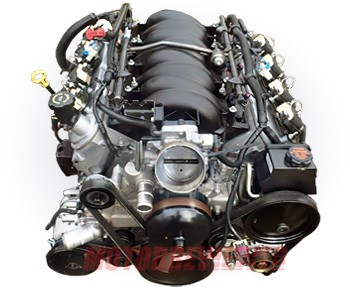GM 5.7L LS1 Engine Specs, Problems, Reliability, Info

5.7L LS1 Small Block V8 Engine Info
The 5.7 LS1 V8 is an all-aluminum, gasoline, 5.7-liter NA V8 engine that was introduced in the 1997 Chevrolet Corvette. This motor has started the third generation of GM's Small Block V8 family. Despite similar displacement, the LS1 engine has almost nothing in common with its predecessor, the Gen II LT1 engine. Initially, the LS1 engine was rated at 345 hp and 350 lb-ft of torque. However, numerous improvements were made to the engine over its lifespan, resulting in a final output of 382 hp and 510 lb-ft of torque. There were also less powerful versions developing 302-335 hp, which were used in the GM F-Body vehicles such as the Chevrolet Camaro and Pontiac Firebird Trans Am, among others. Let's look at how these V8 engines are built and find out their specs, pros, and cons.
5.7L LS1 Engine Overview
The LS1 engine is built around a lightweight cast aluminum cylinder block with cast iron sleeves, a 90-degree cylinder angle and 4.400-inch bore centers. It features six-bolt main caps, cast iron crankshaft, 6.098-inch-long powdered metal I-beam connecting rods, and flat-top cast aluminum alloy (M142) pistons. The engine utilizes a pushrod OHV design with a single hydraulic roller-lifter camshaft. Cylinder heads are made of aluminum as well. They came with two valves per cylinder, cathedral-shaped intake ports, oval exhaust ports, steel solid-stem intake and exhaust valves, and roller-pivot rocker arms. Intake valve diameter is 2.000 inches (50.8 mm), exhaust valve diameter — 1.550 inches (39.4 mm). The specifications of the camshaft vary depending on the application and the model year.
All Gen 3 small block engines feature port-fuel electronic injection. The LS1 got EV1 fuel injectors with a flow rating from 27.3 lbs up to 30 lbs, depending on the model year. The intake manifold is made of composite material, and it fitted with 3-bolt 78-mm throttle body. Corvette's LS1 had electronic throttle control (drive-by-wire), while F-Body/GTO models came with cable operated throttle. All LS1 V8s use a 24X crankshaft reluctor wheel and precise electronic ignition system with individual coils per each spark plug. On the exhaust side, there are cast iron 4-to-1 short-header exhaust manifolds and catalytic converters.
5.7L LS6 Version
Basically, the LS6 is a higher-output (HO) version of the LS1 engine, which was produced from 2001 to 2005 and was used in the high-performance C5 Corvette Z06 and Cadillac CTS V-series models. The LS6 block has the same architecture as the LS1 block, but it is stronger. Cylinder heads feature D-shaped exhaust ports, hollow stem intake valves, and sodium-filled stem exhaust valves. The LS6 also got a more performance-oriented camshaft with higher lift and longer duration. The compression ratio is slightly higher — 10.5:1 instead of 10.2:1. All these mods brought the max output up to 405 horsepower and 400 lb-ft of torque. In 2006, the Z06 was equipped with a new 7.0-liter V8 engine, known as the LS7, which replaced the LS6. The V-Series, on the other hand, received a 6.0-liter engine, known as LS2.
Engine Specs
Oil recommendations and capacity may vary depending on the car model, year, and market. Please check the service manual specific to your vehicle!
Most Common LS1 Engine Problems
The LS1 is widely considered to be a very strong and durable powerhouse that has become an icon of performance and reliability. However, early models had some issues with oil consumption and pushrods. It is worth noting that even the most reliable engines also have some weaknesses and do not last forever.
Oil Consumption
Oil consumption issues can be caused by worn piston rings and valve guide seals, or PCV system, that sucks crankcase gases and engine oil blow-by from the valve cover. Running low on oil can seriously damage the engine. Therefore, it is important to keep a close watch on oil levels and address any abnormal consumption as soon as possible.
Water Pump Leaks
Water pump gasket leakage is a common issue with LS engines. This is slow leakage, and it's easy to fix. But the more critical problem is a bad water pump shaft, which can result in substantial coolant loss and engine overheating.
Bent Pushrods
The LS1 pushrods can bend at higher rpm. Driving aggressively and over-revving the engine can cause the pushrod to hang up or tilt, resulting in bent or snapped pushrods. Bad pushrods can cause pistons to collide with valves, which can lead to catastrophic internal damages.
Weak Connecting Rod Bolts
The LS1 engines manufactured prior to 2001 came with a less robust connecting rod bolt. This is the next weak spot that often leads to failure when the engine is pushed too hard. The LS6 rod bolts are more durable and can better handle the increased stress.
GM LS1 Reliability
The 5.7L LS1 is a reliable engine known for its impressive longevity and robustness. But, as always, maintenance is key to its long-term reliability. Make sure to consistently change the oil, use high-grade motor oil and premium fuel, good quality parts and filters. A properly maintained stock LS1 engine can last well over 300,000 miles. But keep in mind that numerous performance modifications, as well as racing activities, can significantly shorten the lifespan of this engine. As with any high-performance builds, knowledge is power. There are a lot of aftermarket upgrades and beefier components if you want to push it to the limit.
